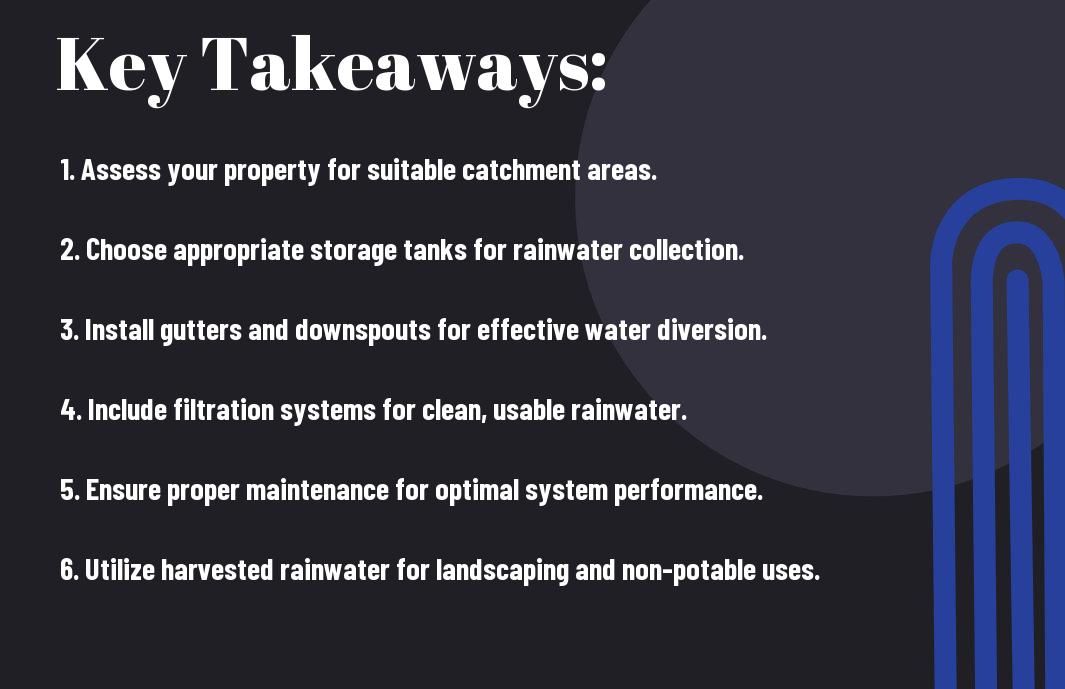There’s a significant opportunity for you to conserve water and reduce your utility bills by installing a rainwater harvesting system. This eco-friendly system allows you to collect and store rainwater for various uses, such as irrigation or washing. In this guide, you will learn imperative steps to set up your system properly, ensuring it operates at peak performance. With careful planning and the right materials, you can maximize the efficiency of your collection efforts, making a positive impact both on your household and the environment.
Key Takeaways:
- Assess your property and local regulations before installation to ensure compliance and optimal design for your rainwater harvesting system.
- Choose the right materials and components, such as gutters, storage tanks, and filtration systems, to maximize efficiency and longevity.
- Implement a regular maintenance schedule to keep the system functioning effectively and prevent contamination or blockages.
Understanding Rain Water Harvesting
Before implementing a rainwater harvesting system, it’s vital to understand its significance. This eco-friendly practice entails collecting and storing rainwater, which can then be utilized for various household and agricultural purposes. By harnessing natural rainfall, you not only reduce your dependence on conventional water sources but also contribute to sustainable water management.
Benefits of Rain Water Harvesting
Harvesting rainwater offers numerous advantages that can positively impact your lifestyle. Some key benefits include:
- Water conservation by reducing consumption of treated water
- Cost savings through lower water bills
- Alleviation of flooding in urban areas
- Improved plant health due to chemical-free water
- Reduced demand on groundwater resources
Types of Rain Water Harvesting Systems
Above are the main types of rainwater harvesting systems you can choose from, depending on your needs and available space. These systems vary in complexity and function, allowing you to select one that aligns best with your objectives. Below is a table outlining five common types.
| 1. Roof-Top Systems | Capture rain from rooftops. |
| 2. Surface Runoff Systems | Collect rainwater from ground surfaces. |
| 3. Soakaways | Allow water to percolate into the ground. |
| 4. Artificial Recharge | Enhance groundwater levels with collected rainwater. |
| 5. Cistern Systems | Store rainwater in large tanks. |
Understanding the various types of rainwater harvesting systems is vital for maximizing their benefits. These systems can be tailored to suit your environment and requirements. With effective implementation, you can enjoy advantages such as:
- Flexible designs tailored for different landscapes
- Scalability to meet your water needs
- Low maintenance requirements
- Increased water security during dry seasons
- Supplementary water supply for irrigation
| 1. Rooftop Systems | Easy to implement; perfect for residential homes. |
| 2. Rain Barrels | Simple and effective; ideal for gardens. |
| 3. Underground Tanks | Space-efficient; great for larger properties. |
| 4. Gravity Feed Systems | Utilize gravity for efficient water flow. |
| 5. Filtered Systems | Provide clean water for household use. |

Planning Your Rain Water Harvesting System
Even the best rainwater harvesting systems start with thorough planning. Consider your specific goals and local regulations, as they will guide the design and implementation of your system. Determine how much water you’d like to collect, where the system will be located, and the necessary components for efficient operation. Documenting these details will not only help you stay organized but will also streamline the installation process.
Assessing Water Needs
Between household usage, garden irrigation, and other activities, it’s important to quantify your water needs. Calculate how much rainwater you will require on average each month to ensure your system can adequately meet those demands. This assessment will help you select appropriate tank sizes and filtration methods tailored to your specific situation.
Evaluating Your Property
After determining your water needs, the next step is evaluating your property for an ideal rainwater harvesting setup. Examine your roof size, drainage patterns, and the topography of your landscape. A well-placed system will maximize rainwater collection and ensure efficient flow into your storage tanks.
Another key aspect of *evaluating your property* is identifying potential obstacles that may hinder water collection. Look for nearby trees, buildings, or uneven ground that could block rainfall from reaching your collection area. Ensure that your collection system is directed away from any contaminated surfaces such as driveways or roadways, as this can affect water quality. By carefully assessing these factors, you can design a more effective harvesting system that promotes maximum efficiency while safeguarding the quality of your collected rainwater.
Necessary Components
Despite the straightforward nature of installing a rainwater harvesting system, certain components are imperative to ensure it functions properly. Each element—from gutters to storage tanks—plays a significant role in collecting, directing, and storing rainwater efficiently. Understanding how these components work together will help you create a system that maximizes water collection and minimizes wastage.
Storage Tanks
Below the surface lies the heart of your rainwater harvesting system: the storage tank. This component must be durable and large enough to hold the collected rainwater. It can be made from various materials, including plastic, metal, or concrete, depending on your budget and needs. The storage tank not only needs to provide ample capacity but also should ensure the cleanliness and safety of the water, so it’s best to choose a tank that minimizes light exposure and keeps out contaminants.
Gutters and Downspouts
With the right gutters and downspouts, you can optimize water collection from your roof. These components are responsible for channeling rainwater from the roof into the storage tank. Make sure your gutters are properly installed and sloped to ensure effective drainage, while downspouts should lead directly toward your storage tank to prevent overflow.
Storage maintenance of your gutters and downspouts is key for an effective rainwater harvesting system. Regular cleaning prevents blockages from leaves and debris, allowing for smooth water flow. Ensure that downspouts are fitted with leaf guards or filters to enhance water quality. Investing time in the upkeep of these components will ensure a more reliable system as you harness rainwater while reducing rainwater waste.
Installation Process
Your journey to maximize efficiency with a rainwater harvesting system begins with proper installation. Follow a structured approach to ensure that each component works seamlessly together, allowing you to collect and store rainwater effectively while minimizing any potential issues.
Preparing the Site
With a clear plan in hand, you should start by selecting an ideal location for your rainwater harvesting system. Ensure the area is free from debris and has easy access for installation and maintenance. Proper grading may also be needed to direct water flow toward your collection system.
Installing Components
Any effective rainwater harvesting system consists of multiple components working in harmony, including gutters, downspouts, filtration systems, and storage tanks. Each part must be installed according to the manufacturer’s specifications for optimal performance.
Further details on the installation will guide you through efficiently assembling each component. Gutters must be positioned to channel water effectively into your system, while downspouts should direct water to your collection tank. It’s crucial to use quality filters to keep debris out of storage and check for leaks regularly, as even small ones can lead to significant water loss. Make sure you adhere to safety guidelines, especially when lifting heavy components or working at heights, to avoid any injuries during installation.
Maintenance and Care
For a rainwater harvesting system to function efficiently, regular maintenance is vital. This involves periodic checks of all components to ensure they are operating optimally. By keeping an eye on your system, you can prevent potential issues that could affect water quality and collection efficiency, ensuring sustainable use of this precious resource.
Regular Inspections
Between rainfall events, conduct thorough inspections of your system. Look for any signs of wear, blockages, or leaks in the pipes and tanks. Ensuring every part is in good condition will help maintain maximum efficiency in water collection and storage, preventing costly repairs in the long run.
Cleaning and Repairs
Along with regular inspections, cleaning your water harvesting components is vital to prevent contamination and ensure optimal performance. Address any repairs promptly, as neglect could lead to more significant issues later on.
The cleaning process includes scrubbing the gutters, filters, and storage tanks to remove debris and algae. Failure to do so can compromise the quality of your harvested water, leading to potential health risks. Additionally, repairing minor leaks or cracks right away can save you from facing extensive damages that could halt your water collection. By maintaining your rainwater harvesting system diligently, you not only promote its longevity but also enhance its efficiency in providing you with clean, sustainable water.

Legal Considerations
Unlike many home improvement projects, installing a rainwater harvesting system comes with important legal considerations that you must address. Familiarize yourself with local regulations and permit requirements, as failure to comply could result in fines or the need to dismantle your system. Ensuring that you are legally compliant not only protects your investment but also promotes safe water management within your community.
Local Regulations
Local governments often have specific laws governing the collection and use of rainwater. You should check with your municipality for any permits, restrictions, or zoning regulations that may apply to your rainwater harvesting system. Understanding these local requirements is crucial to ensure that your setup complies with community standards.
Water Rights and Permits
For rainwater harvesting, you may need to familiarize yourself with water rights laws and obtain any necessary permits. This can involve navigating a complex landscape of state and local regulations that determine how much water you can collect, store, and use.
Considerations regarding water rights and permits vary widely by location. Check with your local water authority or environmental agency to determine the specific requirements for your area. Acquiring the necessary permits not only protects your investment but also aids in responsible water management. Ignoring these regulations can lead to severe penalties, including fines or the dismantling of your system. Understanding your region’s water rights can empower you to make informed decisions about your system’s capacity and usage.
How Does Proper Roof and Gutter Maintenance Impact the Efficiency of a Rain Water Harvesting System?
Proper roof and gutter care is essential for maximizing the efficiency of a rainwater harvesting system. Clean gutters prevent blockages, allowing water to flow freely into storage tanks. Additionally, well-maintained roofs minimize contaminants, ensuring that harvested rainwater is cleaner and more suitable for various uses, from irrigation to household needs.
Conclusion
Presently, installing a rainwater harvesting system can significantly enhance your efficiency in water usage and conservation. By following the outlined steps, you empower yourself to make a sustainable choice that benefits both your household and the environment. Taking the time to properly set up your system will not only provide you with a reliable water source but also reduce your dependence on municipal supplies. Embrace this opportunity and transform your water management practices for a greener future.
FAQ
Q: What are the initial steps I should take before installing a rainwater harvesting system?
A: Before installation, assess your property to determine the best catchment area, usually the roof. Calculate the potential rainfall that can be collected based on the surface area, and check local regulations regarding rainwater harvesting. Additionally, gather the necessary materials such as gutters, downspouts, a storage tank, and filtration systems. It’s also beneficial to create a plan outlining the layout of the system, including where the collection, storage, and distribution components will be located.
Q: How do I select the right size for my rainwater collection tank?
A: The size of your collection tank should be based on your water usage needs and the amount of rainfall in your area. Start by calculating your total roof area in square feet, then multiply this by the average rainfall in inches for your area. This will give you an estimate of how much water you can collect. It’s also important to consider peak usage periods and drought conditions; a larger tank may be necessary to ensure you have enough water during dry spells. Consulting a professional can also help in making the best choice for your situation.
Q: What kind of maintenance is required for a rainwater harvesting system?
A: Regular maintenance is vital to ensure the efficiency of your rainwater harvesting system. This includes cleaning gutters and downspouts at least twice a year to prevent blockages. Inspect the filtration system to ensure it is functioning correctly, and clean or replace filters as needed. Periodically check the storage tank for any sediment buildup and, if necessary, flush out the tank to maintain water quality. Also, ensure that any pumps or distribution systems are in working order, and conduct routine inspections for leaks or wear over time.


